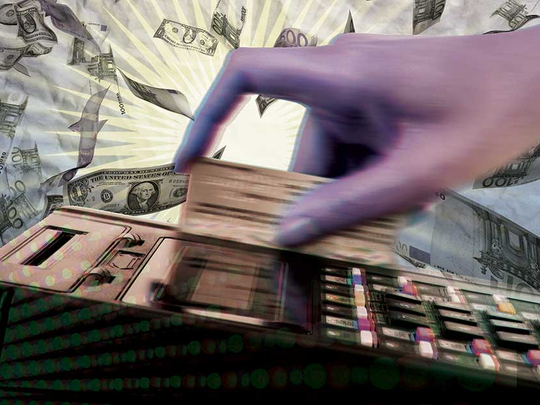
Will the digital revolution get the better of physical currencies, a cornerstone of trade since 700 BC and a key fixture of modern society and government?
Whether using cards, transfers, or cellphones, paying for things is increasingly done without coins or bills. This evolution raises the prospect of a cashless society.
But is that really what we want?
Cash disappears from our daily lives a little more each day. Long gone are the cash registers that used to line bank counters.
READ MORE:
Hoarding cash in UAE: Why it's bad for finances
Multiple credit card applications up in UAE
Cash is still king for majority of UAE consumers
Qatar-linked people, groups on terror list
They were replaced by ATMs, but there are now fewer of those too. The amount of cash we withdraw is also decreasing, down -1.1 per cent in France last year.
Meanwhile, the alternatives to cash are growing rapidly — up more than 10 per cent globally in 2015 — according to the consulting firm Capgemini.
“The dematerialisation of payments is a spectacular rising tide,” explains Gilles Grapinet, CEO of Worldline.
In France, half of payments are made with a banking card, with a volume of transactions that has been growing on average 8 per cent every year since 2000. The more recent rise of contactless payments accelerates the trend.
“The average amount paid by card decreases steadily as it challenges cash, historically the preferred method for small payments,” explains Christophe Vergne, head of card payments and practices at Capgemini Global Financial Services.
Still, cash is putting up a fight, even in developed countries.
Money still has it
“Cash isn’t going to disappear,” says Delphine Lalanne, who heads fiduciary activities at the Bank of France. The volume of bills in Europe rules in her favour. In 2016 in France, it went up 7 per cent in quantity and 6 per cent in value. Money — as in the kind you can hold, feel and smell — still has it!
“The French and the Europeans are still very much attached to cash,” says Lalanne. “Some predict its extinction, but let’s not forget that it’s the customers, the users, who are king and define the method of payment best suited to them. A European survey that the European Central Bank will be publishing in the summer shows that 3 times out of 4, in local shops, people prefer to pay cash.”
There’s a trust factor when it comes to cash. “It remains the only payment method that has an instantaneous, universal liberating power. It’s the legacy of the prince’s privilege to mint coins,” the Bank of France official explains.
Being able to pay everywhere, in every circumstance, without any doubt about the value of your method of payment remains the real, or supposed, privilege of cash. Cash reassures people.
In 2008, after the collapse of Lehman Brothers on September 15, demand for euro bills went up by an additional €38 billion (Dh159.4 billion) between late September and late October. “We took part in a simulation of a flood in Paris.
And together with feedback from natural disasters from abroad — Fukushima, for instance — we know that we’d face a surge in the demand for cash, especially if technological and electrical infrastructures are affected,” says Lalanne.
But printing, handling and secure transportation of cash are costly — representing between 0.29 per cent and 0.72 per cent of gross domestic product, according to a 2011 study by Denmark’s central bank.
There’s also the fact that cash is a vehicle for fraud, tax evasion, gray or black market activities, and corruption, as well as organised crime and even terrorism.
One thing’s for certain: Large denomination bills have a tendency to vanish. The €500 note is a case in point. We hardly ever encounter them. And yet, there were €269 billion worth of them in circulation as the end of 2016.
They’re generally used as hoard money, hidden underneath mattresses or inside safes. Others are used by crooked people or organisation, and we don’t really know in what proportions. What we do know is that more than 30 per cent of the euros in circulation are outside of the Eurozone.
Innovations in payment methods — from the good old debit card to paying with your smartphone — operate hand in hand with the ongoing commerce revolution. “In the digital era, retailers are reinventing the customer experience to make it as smooth as possible,” Gilles Grapinet explains.
“And in that respect, cash reveals its fundamental limit: It cannot accompany the digital commerce revolution.” The Worldline CEO calls the shift in commerce a “weapon of mass destruction” against cash. “We are killing the cash registers. And what are cash registers good for, except keeping cash?”
Digital payment versus cash is also a battle of two lobbies. “The extinction of cash is also a theory disseminated by pressure groups,” one expert notes. Digital payments, after all, aren’t free of charge. Their development implies a massification that generates commission payments from retailers. They also make it easier to collect commercially exploitable data, the equivalent of gold for the 21st century.
In addition, the modernisation of payment methods allows for greater liquidity of the banking market and more competition, as it favours the emergence of new actors in a market where it can be difficult to make a name for oneself.
The European Union, in that sense, plays the role of a stimulant. “The new European directive on payment services will accelerate the replacement of cash by digital methods of payment,” says Christophe Vergne.
“Some countries have declared war on cash. In Northern Europe, they did so to accompany the digital evolution of society. In some African countries, for security reasons. In India, to fight against corruption.”
Thus, the cashless society starts having its own supporters and theorists. The former IMF economist Kenneth Rogoff became one of its advocates with his book The Curse Of Cash, published last year. The amount of cash in circulation represents $4,200 (Dh15,414) per person in the United States, children included, he insists. A lot more than necessary for any honest human activity. So instead of reaching a full extinction of cash, he defends a cash de-growth process, starting with the withdrawal of large-denomination bills.
Making light of the rules
The idea is gaining ground around the world. In the middle of last year, the European Central Bank initiated the trend by ending the printing of €500 bills — a controversial move. More importantly, in November 2016, India’s government abruptly declared invalid all bills of 500 and 1,000 rupees (Dh56.7) in an unprecedented and slightly chaotic operation.
Six months later, it’s difficult to draw clear conclusions from this huge demonetisation operation, the goal of which was to declare war on the gray economy and corruption.
Others have turned to less spectacular measures, like imposing limits on cash transactions. In France, the cap was brought down from €3,000 euros to €1,000 in September 2015.
That being said, the image of briefcases and envelopes filled with money shouldn’t overshadow the other payment methods used by criminals, big or small. Transfers, offshore accounts, trusts, etc. the gray economy skilfully makes light of financial rules. And the increasing number of scams and blackmail hackers take advantage of the rise of alternative currencies such as bitcoin.
“The extinction of cash wouldn’t erase money laundering or tax fraud,” Lalanne insists.
Monetary policy also plays a role in this debate. Ever since major central banks made a foray into the then unexplored territory of negative interest rates, cash has become an obstacle to the propagation of their policy. When it costs money to deposit money in a bank, users have an incentive to keep it at home. In Switzerland, the 1,000-franc bill became very popular after negative interest rates were introduced.
Pioneer
Sweden is a pioneer country when it comes to money. That’s where the first bank notes were invented and where the first national central bank was created, in the late 17th century.
Sweden was also the first to introduce negative interest rates in 2015. And the Nordic country is ahead of the curve when it comes to cashless societies. Going cashless is a goal openly admitted to by the authorities, so much so that they even promoted it on the state-run website Sweden.se.
The Swedes no longer pay, they “swish.” Swish is the name of a payment app launched by Swedish and Danish banks. And although ABBA sang Money, Money, Money, the museum dedicated to the Swedish band in Stockholm doesn’t accept any cash. Another piece of evidence of the willingness to switch is that any shopkeeper in Sweden has the right to refuse payments in cash.
As a consequence, the volume of cash only represents 2.1 per cent of the GDP in Sweden compared to 10.3 per cent in the Eurozone and 7.7 per cent in the US, according to Capgemini.
The Swedish example attracts much discussion in the world of payments. For some, it’s a full-scale showcase of the prospects of tomorrow’s digital world.
Risk of exclusion
For others, it raises serious concerns: First of all, about the risk of more exclusion for the poorest and the weakest members of society, but also about the risk of a Big Brother-like turn that would, in the future, ban all non-traceable transactions and limit individual freedoms and the right to property.
We’re not there yet — far from it. The field of payment methods is unique in that no innovation has ever succeeded in completely replacing the former payment method.
“Digital methods of payments widen the offer. They’re not a replacement for cash,” says Lalanne.
Cash is resisting and bank cards continue to grow despite the rise of transfers and mobile payments. Even cheques are managing still to survive.
We can rest assured, in other words, that our beloved bills will be with us for a while yet.
— Worldcrunch, in partnership with Le Figaro/New York Times News Service
Bertille Bayart is editor-in-chief in the Industry & Services division of Figaro Economie.










